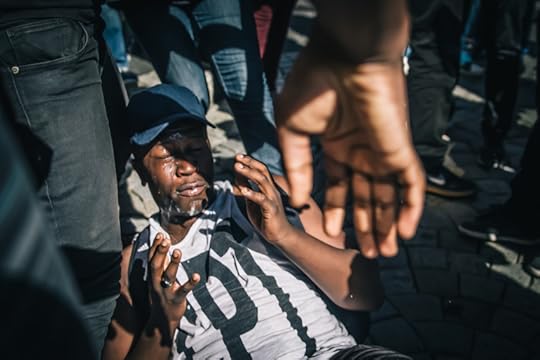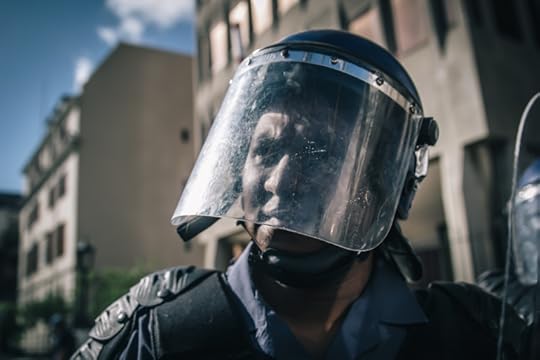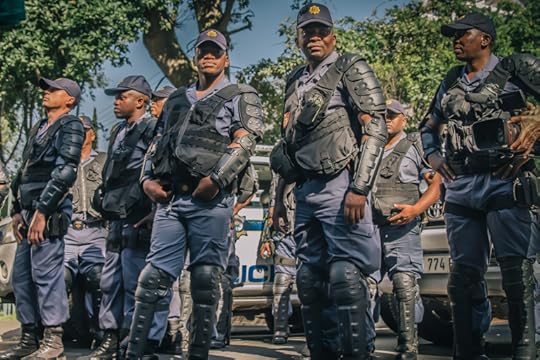The Hooligans
A black coated Nylophor fence transverses the Union Building lawns the day #FeesMustFall marched to the Union Buildings in Pretoria. The fence creating a ceremonial space for protest below and, at the top, the Union Buildings edifice with a tall sculpture of former president Nelson Mandela with his arms wide open in cruel irony. The fence is secured by Bekafix posts and impenetrable (or so we thought). To others, students from Tshwane University of Technology (TUT) Soshanguve campus, especially, it was relative – it could be bent and broken and torn apart: it could be transform from a deterrent into something else, even an entrance, perhaps. In tearing the fence open TUT Soshanguve students altered the relationship between the State and its citizens at that moment of ceremony.
They folded the distance between power and people upon itself, shortening the distance by half. One got the feeling that this particular protest action was not on the cards for most people who were in attendance—for that’s what most of us were there to do, to attend a ceremony where President Jacob Zuma would speak and, hopefully, placate our frustrated energy and tell us something we could take home, something that would render all the effort of driving or taking the Gautrain to Pretoria, worth it.
But TUT Soshanguve – who had by now been derided on social media as ‘hooligans’ – had already muddied our symbolic defiance of the State and made matters worse for everyone. They had caused us great panic and even greater regret to having come to this untethering of Pretoria’s urban youths, to experience the stripped down version of revolution; the one were the state shows its fangs vis-a-vis its heavy handed riot police with its rubber bullets and tear gas and stun grenades and what have you; and the gathered residuum retaliating by equally destructive means – a brick here, a petrol bomb there, a burnt down mobile toilet or two. My friend and I had stood far back enough to notice the happenings by the fence. Each time the TUT Soshanguve students made head way with the fence the police stung them with stun grenades. Every single stun grenade was met with a “Happy!” from the students as though it were New Year’s.
This joy in that which was so blatantly violent was as tragic as it was comical to those of us who deplore violence in all its forms, but at this moment, at this proximity with real revolution, with the real risk of catching a rubber bullet to the leg, our outrage froze inside our bone marrow. So we tweeted it instead. The violence unfolding in front of us and the way in which we casually watched at such close proximity, without raising a single finger or placing our bodies between the riot police and the TUT Soshanguve students, spoke of the ways in which violence is naturalised in this country, especially between the State and its citizens. We all knew something about what was happening and we all knew not to intervene. Violence of the State against its own citizens usually points to its illegitimacy than its power. It points to cracks in the syntax of power. To those who had come with the intent to demonstrate those exact same cracks this state of affairs glimmered with hope. Finally, the South African government, the president himself, would have nowhere to hide his true face. Today he would kill his children and the entire world was watching and the riot police feigned restraint while grinding their teeth behind riot shields.
Tear gas canisters fell from the sky – from a police helicopter – onto anyone and everyone. Teargas chokes, suffocates and repels. It stings the eyes. From here on it was clear that the president wouldn’t come out. TUT Soshanguve students were still working their way through the fence as though tear gas were the very air they breathe in their neighbourhoods. It is important to draw the distinction between ‘symbolic violence’ and the violence the intimate violence of poverty and squalor which snatches food from your cupboards, haunts your dreams and denies you choices, poisoning the water you drink and the very air you breathe. It is inside these homes that symbolic violence finds its similitude in physical violence. It is here that it is mirrored with devastating effects. And it is also here that the signatures of power speak the loudest.
As we watched with teargas filled tears the coterie of sinewy TUT Soshanguve students finally rip through the Nylophor fence, uproot the Bekafix posts and put their hands up in the air in surrender before getting down on their knees to disarm their rage, we were somewhat relieved. It became apparent they only wanted to tear down the boundaries that separate State and citizen. They wanted to be allowed into the space that purports to be theirs to own. In their tenacity to tear down the fence that transverses the Union Building, they had succeeded in restoring the Union Buildings into its proper function as a public institution.

We ambled in after them through the hole in the fence in quiet disbelief. To some us the fence had a justification somewhere in the back of our heads, if one cared to look there and rummage with both hands. The fence needed to be there, this we knew. Especially those of us of middle class leaning. We are accustomed to high walls and electric fences. We know whom they are meant to deter. But here, at the Union Buildings, in this supposedly public space, our grasp of borders and privileged spaces nearly made a mockery of our own supposed intelligence. Here were these outsiders, writ large in the language of violence and derided as Hooligans on Twitter, demonstrating to us and the rest of the world how to communicate with a government that only speaks fluent violence against its own citizens to preserve middle class illusions and maintain upper class affluence while defending its own unbridled corruption. When The Hooligans climbed the top of Police Nyalas to look the president in the eye had he come out to deliver his speech, some among us joined them. There was a sense of passing through an impossible threshold once you went through the torn down fence. There was a genuine, visceral sense of victory when you drank from the sprinklers with your bare hands and dabbed your teargassed face with the cool water inside the beautifully manicured lawns along the first steps of the Union Buildings.
People gathered tiredly under the tall trees and conversed. The riot police, which were not so long ago a sign of imminent danger were now but negligible gnomes – forming part of the landscaping. To think that to get here it took less than 50 people out of a couple of thousands – potentially – had given me a glimpse of the power we have as citizens. It was clear at this point that the president wasn’t going to come out. If I were him I’d have done the same. Here were people who tore the fence that divided them from power, and with it tore open their hearts and bled right there in front of us in fits of rage for justice. My president enjoys a good laugh but The Hooligans had demonstrated that today would not be a laughing matter. There would be no chortling and clearing of the throat; there would be no meandering around a point and beating about the bush. The language of violence from the State had, on this day, found its mirror. Even better, it had found its partner that would finish its sentences. The Hooliganism of State had finally met what it had procreated in poor communities and in the wells of minds of its most vulnerable citizens. And we stood there, stunned in clumps of bewildered middle class markers, cloaked in suburban revolutionary language, caught in the middle of a conversation between two lovers, who had sized each other up well before hand and had met on this day on terms that only lovers understand. I knew then that it was time to drive home, to get on the freeway to Johannesburg. There was a tension I couldn’t quite decipher. Evening was approaching and I knew that by night lovers will do only what lovers are prone to do. This was only a visceral intuition I could not quite shake off. As we drove onto the M1 the first shots were fired by the riot police and by the time we arrived at Wolves on Corlett Drive in Illovo for a beer, the first police van had been set alight. By the time our partners came to meet us after work, there were students who wanted to abandon the revolution and go home. And by the time I got down to write this, a few universities had agreed to end the exploitive practice outsourcing their general staff, a decision that our erstwhile president, barricaded inside the Union Buildings couldn’t even attempt to make on that decidedly hot Friday afternoon.

If anything, that fateful Friday exposed not only the hubris of power and language of state and the way in which that language and its violence inscribes itself on vulnerable black bodies; it revealed the fissures in the solidarity between privilege black bodies and not so privileged ones in times of struggle; it pointed to the modulations of similitude within the movement itself – where common ground reflects common convenience and where and when shifts to reflect different class conveniences within struggle itself. The fractures in the student movement are a mere microcosm of the heterogeneous experience of black bodies in South Africa, and as such, were to be expected. In the end, it revealed that fidelity to revolution becomes a matter of convenience or necessity depending on one’s proximity to the centre that holds all the power of economic, political, cultural and social currency.
Sean Jacobs's Blog
- Sean Jacobs's profile
- 4 followers




